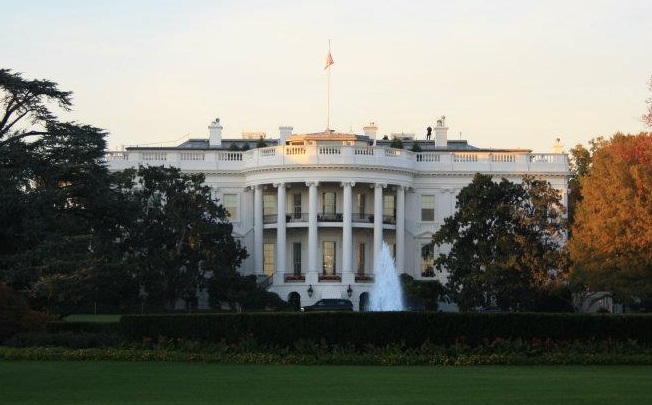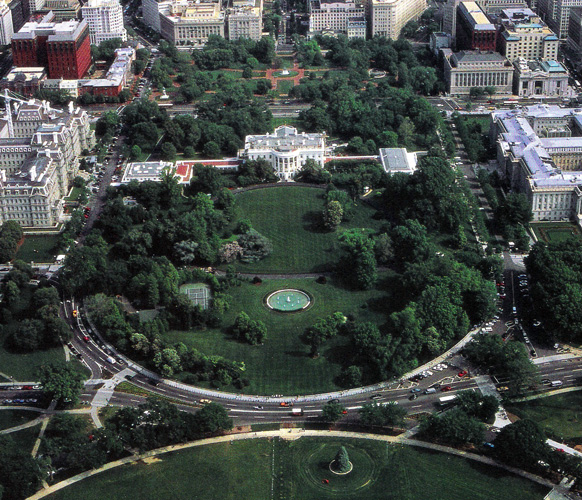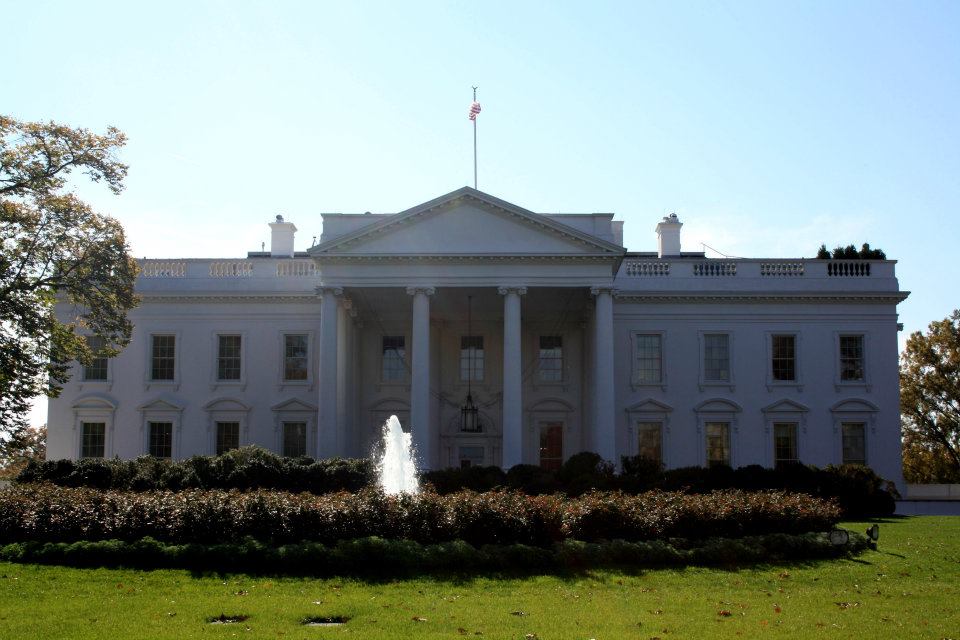The White House
Contents |
[edit] Introduction
The White House in Washington D.C. has been the official residence of the President of the United States since 1800.
George Washington, America's first President, chose the site for the White House in 1791. The first cornerstone was laid in 1792, and, following a competition for the design of the President's new mansion house, Irishman James Hoban was selected as the architect.
Throughout its history, the house has been known by a variety of names, such as the 'President's Palace', the 'President's House', and the 'Executive Mansion'. It wasn't until 1901 that President Theodore Roosevelt gave it the name 'The White House'.
Situated on Pennsylvania Avenue part way between the Washington Monument and the State Capitol Building, the White House is seen as an emblem of American state power and remains one of the most recognisible buildings in the country.
[edit] Design and construction
Hoban was inspired by the classical architecture of the Roman Vitruvius and the Renaissance-era Andrea Palladio. While several buildings have been cited as principle inspiration for Hoban's design, the upper floors of Leinster House in Dublin has been singled out as the most verifiable influence.
Palladian architecture had inspired a many buildings of monumental style in Western Europe, and the White House's southern facade is a combination of the Palladian and neoclassical architectural styles. The ground floor is rusticated in the Palladian fashion with a neoclassical projecting bow of three bays at the centre of the facade. The whole building was to be white-painted Aquia Creek sandstone.
However, Washington was displeased with Hoban's original design submission, deeming it to be too small and not sufficiently monumental to befit the President. His recommendations, for two storeys to be increased to three, and for the nine-bay facade to be increased to 11, were incorporated by Hoban.
The construction, undertaken largely by an enslaved and free African-American workforce, was still underway when President John Adams became the first leader to move into the house in 1800.
In 1814, the invading British stormed the White House and set fire to it, destroying the roof and interior. Despite subsequent calls for the President's residency to abandon the site for a new location, or even city, President James Madison employed Hoban to oversee the renovation of the existing building.
The White House was fully renovated according to the original designs in time for the newly inaugurated President James Monroe to move into it in 1817. The South Portico was constructed during Monroe's administration in 1824, and the North Portico was constructed during President Andrew Jackson's administration in 1829.
[edit] Post-construction
The building remained largely unchanged for the rest of the 19th century, until in 1902, President Roosevelt embarked upon a major renovation project. This involved relocating the President's offices from the second floor to the newly-constructed West Wing. Subsequently, President Taft constructed the Oval Office within an enlarged office wing at the front-centre of the building.
During the 1950s, serious structural issues plagued the building, prompting President Harry Truman to begin another renovation project, involving the dismantling of everything except the external superstructure. This project was completed in 1952. Since this major renovation, no substantive architectural changes have been made to the building.
The White House is now a National Heritage Site, owned by the National Park Service. The complex includes the Executive Residence, West Wing, East Wing, the Eisenhower Executive Office Building, and a guest residence called Blair House. There are six storeys containing 132 rooms that are used as offices, accommodation and for entertaining guests from around the world. The kitchen is able to serve dinner to up to 140 guests.
It is regularly featured in film and TV, most notably the American series 'The West Wing' and the 1996 blockbuster 'Independence Day' in which it is shown being destroyed by an alien spaceship.
There is a persistent rumour that President Abraham Lincoln's ghost, also known as 'the White House Ghost', has haunted the building since his death in 1865.
It is interesting to note the words President John Adams is reported to have written in a letter to his wife on having become the first President to take residence in the building: 'I pray Heaven to bestow the best of blessings on this House, and all that shall hereafter inhabit it. May none but honest and wise men ever rule under this roof...'
[edit] Project data
- Address: 1600 Pennsylvania Avenue, Washington D.C.
- Construction started: 1792
- Completed: 1800
- Architect: James Hoban
- Construction cost: $232,371
- Owner: US National Park Service
[edit] Related articles on Designing Buildings Wiki
- 9 of the world's most impressive structures.
- 10 Downing Street.
- Building of the week series.
- Empire State Building.
- Fallingwater.
- Flatiron Building.
- Guggenheim Museum, Bilbao.
- Lincoln Memorial.
- Neoclassical architecture.
- One World Trade Center.
- Palace of Westminster.
- Palladian architecture.
- The Kremlin.
- The Pentagon.
- Trump Tower New York.
- Unusual building design of the week.
- US Air Force CCLD, Colorado.
- US Capitol Building.
[edit] External references
- White House - Official site
Featured articles and news
Homes England supports Greencore Homes
42 new build affordable sustainable homes in Oxfordshire.
Zero carbon social housing: unlocking brownfield potential
Seven ZEDpod strategies for brownfield housing success.
CIOB report; a blueprint for SDGs and the built environment
Pairing the Sustainable Development Goals with projects.
Types, tests, standards and fires relating to external cladding
Brief descriptions with an extensive list of fires for review.
Latest Build UK Building Safety Regime explainer published
Key elements in one short, now updated document.
UKGBC launch the UK Climate Resilience Roadmap
First guidance of its kind on direct climate impacts for the built environment and how it can adapt.
CLC Health, Safety and Wellbeing Strategy 2025
Launched by the Minister for Industry to look at fatalities on site, improving mental health and other issues.
One of the most impressive Victorian architects. Book review.
Common Assessment Standard now with building safety
New CAS update now includes mandatory building safety questions.
RTPI leader to become new CIOB Chief Executive Officer
Dr Victoria Hills MRTPI, FICE to take over after Caroline Gumble’s departure.
Social and affordable housing, a long term plan for delivery
The “Delivering a Decade of Renewal for Social and Affordable Housing” strategy sets out future path.
A change to adoptive architecture
Effects of global weather warming on architectural detailing, material choice and human interaction.
The proposed publicly owned and backed subsidiary of Homes England, to facilitate new homes.
How big is the problem and what can we do to mitigate the effects?
Overheating guidance and tools for building designers
A number of cool guides to help with the heat.
The UK's Modern Industrial Strategy: A 10 year plan
Previous consultation criticism, current key elements and general support with some persisting reservations.
Building Safety Regulator reforms
New roles, new staff and a new fast track service pave the way for a single construction regulator.

























